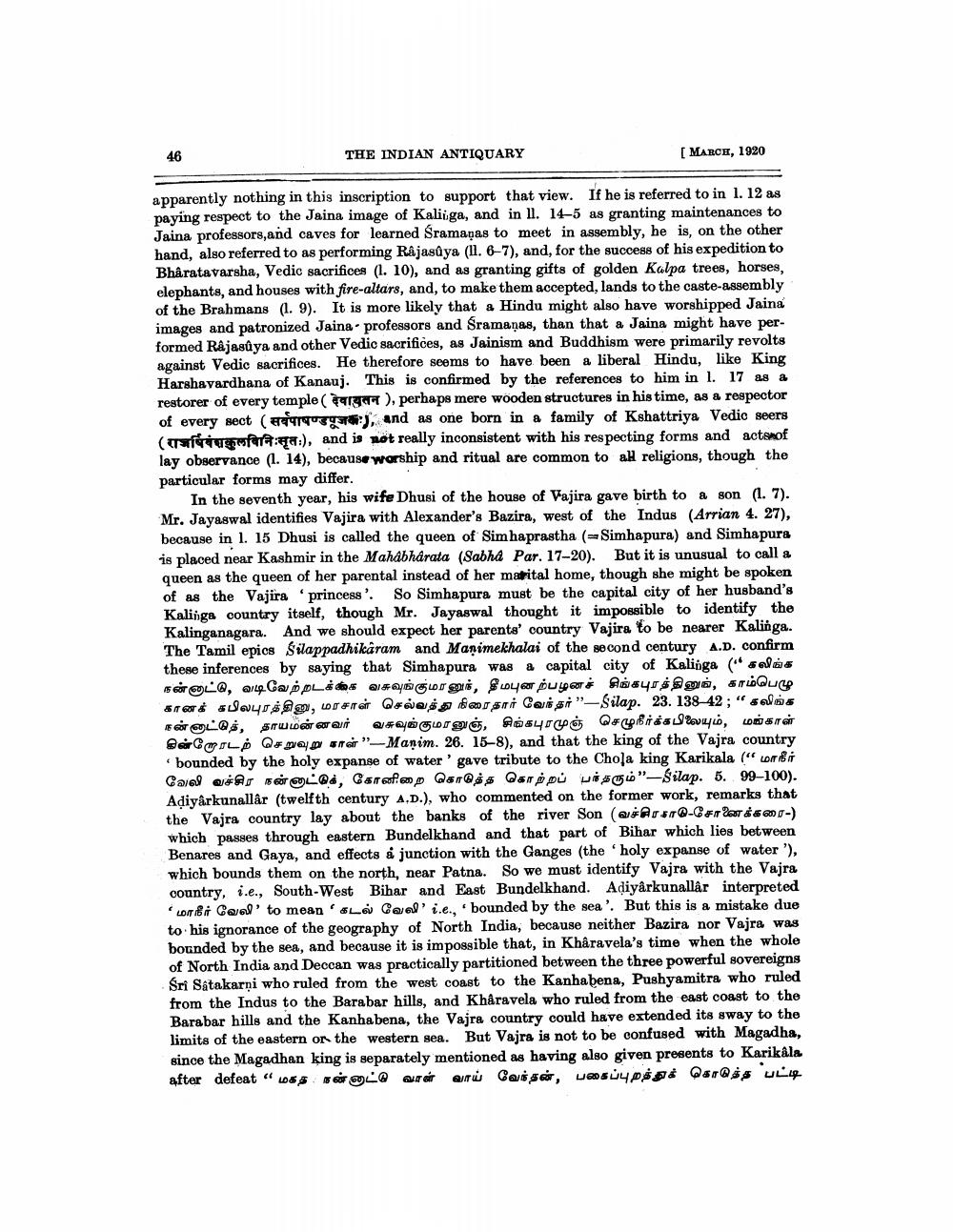________________
46
THE INDIAN ANTIQUARY
[ MARCH, 1920
apparently nothing in this inscription to support that view. If he is referred to in l. 12 as paying respect to the Jaina image of Kaliiga, and in 1l. 14-5 as granting maintenances to Jaina professors, and caves for learned Sramaņas to meet in assembly, he is, on the other hand, also referred to as performing Rajasaya (11. 6-7), and, for the success of his expedition to Bhâratavarsha, Vedic sacrifices (1. 10), and as granting gifts of golden Kalpa trees, horses, elephants, and houses with fire-altars, and, to make them accepted, lands to the caste-assembly of the Brahmans (1. 9). It is more likely that a Hindu might also have worshipped Jaina images and patronized Jaina professors and Sramaņas, than that a Jaina might have performed Rajasůya and other Vedic sacrifices, as Jainism and Buddhism were primarily revolts against Vedic sacrifices. He therefore seems to have been a liberal Hindu, like King Harshavardhana of Kanauj. This is confirmed by the references to him in l. 17 as a restorer of every temple (aga), perhaps mere wooden structures in his time, as a respector of every sect ( 1997), and as one born in a family of Kshattriya Vedic seers (
mara ), and is not really inconsistent with his respecting forms and acts of lay observance (1. 14), because worship and ritual are common to all religions, though the particular forms may differ.
In the seventh year, his wife Dhusi of the house of Vajira gave birth to a son (1. 7). Mr. Jayaswal identifies Vajira with Alexander's Bazira, west of the Indus (Arrian 4. 27), because in l. 15 Dhusi is called the queen of Sim haprastha (Simhapura) and Simhapura is placed near Kashmir in the Mahabharata (Sabha Par. 17-20). But it is unusual to call a queen as the queen of her parental instead of her matrital home, though she might be spoken of as the Vajira princess'. So Simhapura must be the capital city of her husband's Kalinga country itself, though Mr. Jayaswal thought it impossible to identify the Kalinganagara. And we should expect her parents' country Vajira to be nearer Kalinga. The Tamil epics Silappadhikaram and Manimekhalai of the second century A.D. confirm these inferences by saying that Simhapura was a capital city of Kalinga (selas நன்னாட்டு, வடிவேற்றடக்கை வசுவுங்குமானும், தீமபுனற்பழனச் சிங்கபுரத்தினுக், காம்பெழு
& Jayne , Gir @#WA @DJS CONS"-Silap. 23. 138-42;" salos நன்னாட்டுத், தாயமன்னவர் வசுவுக்குமானுஞ், சிங்கபுரமுஞ் செழுநீர்க்கபிலையும், மக்காள் B UILÒ Q#gods ”-Manim. 26. 15-8), and that the king of the Vajra country
bounded by the holy expanse of water' gave tribute to the Chola king Karikala (“orfir Calel o r tit , Garof en p a s a repu wi "-Silap. 5. 99-100). Adiyarkunallar (twelfth century A.D.), who commented on the former work, remarks that the Vajra country lay about the banks of the river Son (aš Arsr-G#TAT ĆE 01-) which passes through eastern Bundelkhand and that part of Bihar which lies between Benares and Gaya, and effects å junction with the Ganges (the holy expanse of water '), which bounds them on the north, near Patna. So we must identify Vajra with the Vajra country, i.e., South-West Bihar and East Bundelkhand. Adiyarkunallar interpreted
Lori Carol' to mean '&L Gaal' i.e., bounded by the sea'. But this is a mistake due to his ignorance of the geography of North India, because neither Bazira nor Vajra was bounded by the sea, and because it is impossible that, in Khâravela's time when the whole of North India and Deccan was practically partitioned between the three powerful sovereigns Sri Satakarņi who ruled from the west coast to the Kanhabena, Pushyamitra who ruled from the Indus to the Barabar hills, and Khåravela who ruled from the east coast to the Barabar hills and the Kanhabena, the Vajra country could have extended its sway to the limits of the eastern on the western sea. But Vajra is not to be confused with Magadha, since the Magadhan king is separately mentioned as having also given presents to Karikala after defeat " மகத நன்னாட்டு வாள் வாய் வேந்தன், பகைப்புறத்துக் கொடுத்த பட்டி




